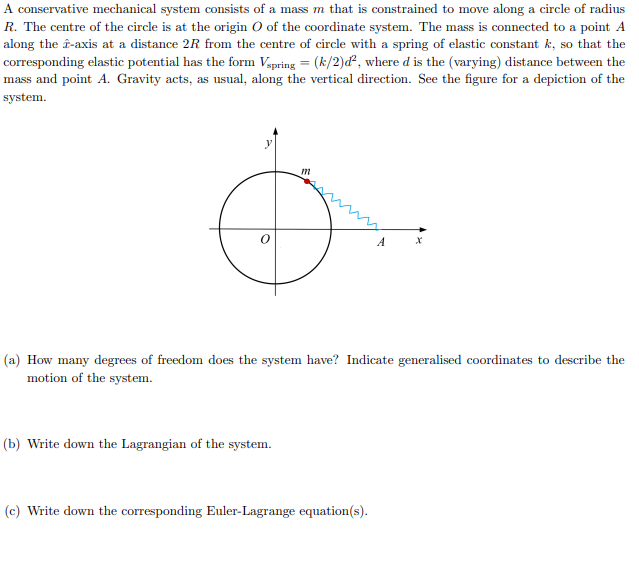A conservative mechanical system consists of a mass m that is constrained to move along a circle of radius R. The centre of the circle is at the origin O of the coordinate system. The mass is connected to a point A along the î-axis at a distance 2R from the centre of circle with a spring of elastic constant k, so that the corresponding elastic potential has the form Vspring = (k/2)d², where d is the (varying) distance between the mass and point A. Gravity acts, as usual, along the vertical direction. See the figure for a depiction of the system.
A conservative mechanical system consists of a mass m that is constrained to move along a circle of radius R. The centre of the circle is at the origin O of the coordinate system. The mass is connected to a point A along the î-axis at a distance 2R from the centre of circle with a spring of elastic constant k, so that the corresponding elastic potential has the form Vspring = (k/2)d², where d is the (varying) distance between the mass and point A. Gravity acts, as usual, along the vertical direction. See the figure for a depiction of the system.
International Edition---engineering Mechanics: Statics, 4th Edition
4th Edition
ISBN:9781305501607
Author:Andrew Pytel And Jaan Kiusalaas
Publisher:Andrew Pytel And Jaan Kiusalaas
Chapter10: Virtual Work And Potential Energy
Section: Chapter Questions
Problem 10.57P: Find the stable equilibrium position of the system described in Prob. 10.56 if m = 2.06 kg.
Related questions
Question

Transcribed Image Text:A conservative mechanical system consists of a mass m that is constrained to move along a circle of radius
R. The centre of the circle is at the origin O of the coordinate system. The mass is connected to a point A
along the â-axis at a distance 2R from the centre of circle with a spring of elastic constant k, so that the
corresponding elastic potential has the form Vspring = (k/2)ď², where d is the (varying) distance between the
mass and point A. Gravity acts, as usual, along the vertical direction. See the figure for a depiction of the
system.
0
m
(b) Write down the Lagrangian of the system.
(a) How many degrees of freedom does the system have? Indicate generalised coordinates to describe the
motion of the system.
X
(c) Write down the corresponding Euler-Lagrange equation(s).
Expert Solution
This question has been solved!
Explore an expertly crafted, step-by-step solution for a thorough understanding of key concepts.
Step by step
Solved in 3 steps with 2 images

Knowledge Booster
Learn more about
Need a deep-dive on the concept behind this application? Look no further. Learn more about this topic, mechanical-engineering and related others by exploring similar questions and additional content below.Recommended textbooks for you

International Edition---engineering Mechanics: St…
Mechanical Engineering
ISBN:
9781305501607
Author:
Andrew Pytel And Jaan Kiusalaas
Publisher:
CENGAGE L

International Edition---engineering Mechanics: St…
Mechanical Engineering
ISBN:
9781305501607
Author:
Andrew Pytel And Jaan Kiusalaas
Publisher:
CENGAGE L